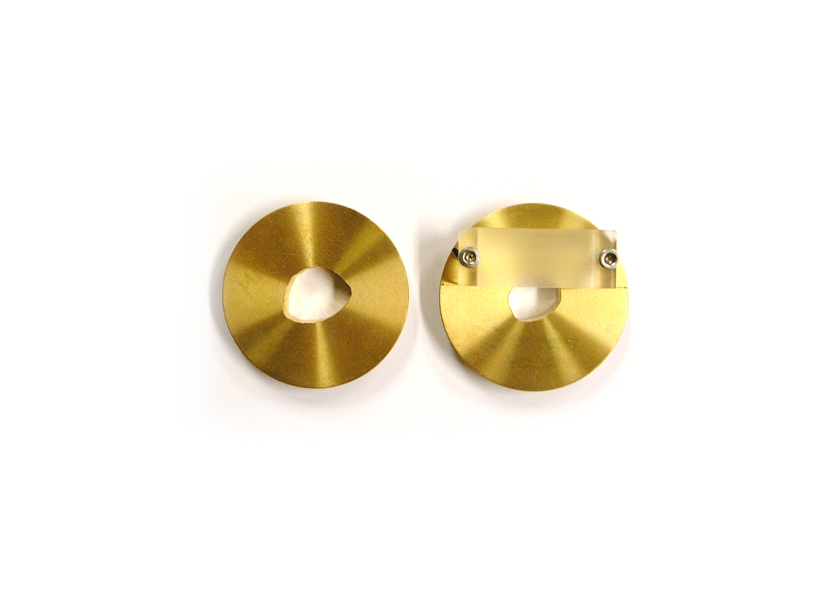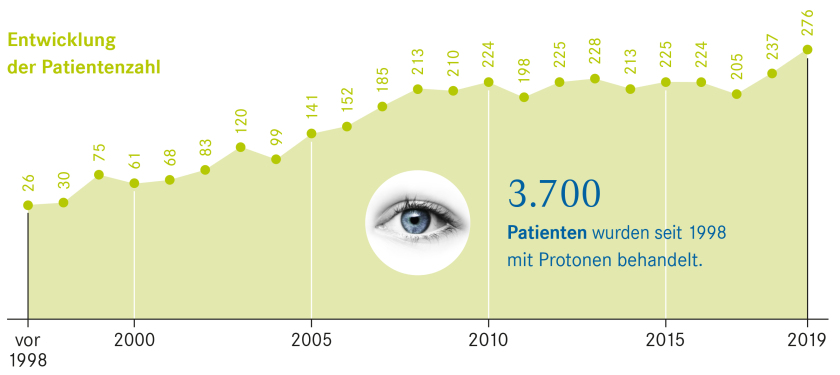20 percent more patients were treated with proton therapy in 2019

An individual eye shield is made for each patient to protect the surrounding tissue from the proton beam. © HZB

Number of patients who received the proton therapy offered jointly by Charité and HZB. © HZB/J. Politt
For more than 20 years, Charité - Universitätsmedizin Berlin and the Helmholtz-Zentrum Berlin (HZB) have jointly offered the irradiation of eye tumors with protons. In 2019, more patients were treated in Berlin-Wannsee than ever before. 276 patients - 20 percent more than in the previous year - underwent proton therapy. The treatment is specialized in choroidal melanomas of the eye. The proton accelerator at HZB is the only treatment facility for this disease in Germany.
500 to 600 people in Germany are affected by a malignant choroidal melanoma every year. In 97 percent of cases, the tumour can be completely destroyed by irradiation with protons. In most cases, not only the eye but also the vision can be maintained to a satisfactory degree. "The energy of the proton beam can be adjusted in such a way that practically only the tumor receives the radiation. Since the protons have a straight trajectory, the lateral scattering is much less than with X-rays," explains Dr. Jens Heufelder, the senior medical physicist at Charité - Universitätsmedizin Berlin. The protons effectively destroy the tumor, while the surrounding healthy tissue is largely spared.
To cope with the increase in patients in 2019, treatment operations at the proton accelerator have been extended to 12 hours. Approximately 45 percent of the patients came from the Berlin-Brandenburg region, the other patients came from other German states and other European countries (approximately 8 percent). The youngest patient who received proton therapy at HZB in 2019 was 8 years old, the oldest patient 96 years old. The average age was 61 years.
Since 1998, more than 3,700 patients have been treated with protons from the HZB accelerator. "The success of proton therapy is based on the collaboration between ophthalmologists, medical physicists and accelerator experts. As a result, the therapy has been continuously improved for the benefit of patients over the past few years", explains Prof. Dr. Andrea Denker, head of proton therapy at HZB.
(sz)
https://www.helmholtz-berlin.de/pubbin/news_seite?nid=21122;sprache=en
- Copy link
-
Green hydrogen: A cage structured material transforms into a performant catalyst
Clathrates are characterised by a complex cage structure that provides space for guest ions too. Now, for the first time, a team has investigated the suitability of clathrates as catalysts for electrolytic hydrogen production with impressive results: the clathrate sample was even more efficient and robust than currently used nickel-based catalysts. They also found a reason for this enhanced performance. Measurements at BESSY II showed that the clathrates undergo structural changes during the catalytic reaction: the three-dimensional cage structure decays into ultra-thin nanosheets that allow maximum contact with active catalytic centres. The study has been published in the journal ‘Angewandte Chemie’.
-
An elegant method for the detection of single spins using photovoltage
Diamonds with certain optically active defects can be used as highly sensitive sensors or qubits for quantum computers, where the quantum information is stored in the electron spin state of these colour centres. However, the spin states have to be read out optically, which is often experimentally complex. Now, a team at HZB has developed an elegant method using a photo voltage to detect the individual and local spin states of these defects. This could lead to a much more compact design of quantum sensors.
-
Solar cells on moon glass for a future base on the moon
Future settlements on the moon will need energy, which could be supplied by photovoltaics. However, launching material into space is expensive – transporting one kilogram to the moon costs one million euros. But there are also resources on the moon that can be used. A research team led by Dr. Felix Lang of the University of Potsdam and Dr. Stefan Linke of the Technical University of Berlin have now produced the required glass from ‘moon dust’ (regolith) and coated it with perovskite. This could save up to 99 percent of the weight needed to produce PV modules on the moon. The team tested the radiation tolerance of the solar cells at the proton accelerator of the HZB.
